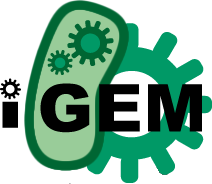Team:Arizona State
From 2011.igem.org
Rubenacuna (Talk | contribs) (added text from proposal) |
Rubenacuna (Talk | contribs) (formatted text) |
||
| Line 6: | Line 6: | ||
---- | ---- | ||
The International
Genetically
Engineered
Machine
(iGEM)
competition
is
the
premiere
undergraduate
synthetic
biology
competition,
encouraging
students
around
the
world
to
develop
novel
applications
for
genetic
engineering.
The
competition
has
grown
from
5
universities
in
2004
to
over
160
universities
in
2011
worldwide.
This
year
iGEM
will
be
holding
a
regional
competition
for
the
Americas
at
the
Institute
for
Biological
Engineering
in
Indianapolis,
where
a
portion
of
contestant
universities
will
move
on
to
the
World
Championship.
The
World
Championship
will
be
held
at
the
Massachusetts
Institute
of
Technology
in
November
2011.
Projects
are
judged
by
their
innovation
and
application
of
gene
networks
to
form
products
with
novel
functions.
Examples
of
past
projects
include
a
H.
pylori
vaccination
candidate,
bacteria
that
solve
sudoku
puzzles,
heavy
metal
detection
using
E.
coli,
and
a
waterborne
parasite
detection
system.
As
ASU's
inaugural
team
we
plan
to
focus
on
NDM‐1
acquired
antibiotic
resistance
and
the
CRISPR‐Cas
pathway.
| The International
Genetically
Engineered
Machine
(iGEM)
competition
is
the
premiere
undergraduate
synthetic
biology
competition,
encouraging
students
around
the
world
to
develop
novel
applications
for
genetic
engineering.
The
competition
has
grown
from
5
universities
in
2004
to
over
160
universities
in
2011
worldwide.
This
year
iGEM
will
be
holding
a
regional
competition
for
the
Americas
at
the
Institute
for
Biological
Engineering
in
Indianapolis,
where
a
portion
of
contestant
universities
will
move
on
to
the
World
Championship.
The
World
Championship
will
be
held
at
the
Massachusetts
Institute
of
Technology
in
November
2011.
Projects
are
judged
by
their
innovation
and
application
of
gene
networks
to
form
products
with
novel
functions.
Examples
of
past
projects
include
a
H.
pylori
vaccination
candidate,
bacteria
that
solve
sudoku
puzzles,
heavy
metal
detection
using
E.
coli,
and
a
waterborne
parasite
detection
system.
As
ASU's
inaugural
team
we
plan
to
focus
on
NDM‐1
acquired
antibiotic
resistance
and
the
CRISPR‐Cas
pathway.
| ||
| + | |||
'''Global
Challenge
''' | '''Global
Challenge
''' | ||
---- | ---- | ||
| - | + | The
WHO
and
CDC
consider
antibiotic
resistance
to
be
one
of
the
most
pressing
global
health
threats,
compromising
the
effectiveness
of
our
most
important
tool
in
fighting
bacterial
infection.
NDM‐1
allows
bacteria
to
be
resistant
to
a
broad
range
of
commonly
used
antibiotics
and
has
spread
rapidly
from
India
and
Pakistan
through out
the
world.
Alternative
solutions
must
be
promptly
and
intelligently
employed
to
counter
this
threat.
| |
| - | threats, | + | |
| - | + | ||
| - | + | ||
| - | + | ||
'''Bacterial
Immunity
''' | '''Bacterial
Immunity
''' | ||
---- | ---- | ||
| - | + | CRISPR
functions
as
a
bacterial
immune
system
by
incorporating
and
targeting
foreign
genetic
elements.
The
modularity
of
this
system
presents
the
opportunity
for
unique
applications.
Our
innovative
solution
uses
CRISPR
to
silence
the
NDM‐1
gene,
consequently
developing
a
new
method
that
can
be
utilized
for
many
novel
gene
manipulations
in
bacteria.
This
project
combats
an
important
global
issue
with
cutting‐edge
science.
As
Arizona
State
University’s
first
iGEM
team,
we
have
chosen
an
ambitious
project
that
has
great
potential
to
advance
the
field
of
synthetic biology,
bringing
an
international
spotlight
to
ASU
and
the
Phoenix
community.
| |
| - | elements. | + | |
| - | + | ||
| - | + | ||
| - | + | ||
| - | + | ||
| - | biology, | + | |
[[Image:Arizona_State_proposal_diagram0.png]] | [[Image:Arizona_State_proposal_diagram0.png]] | ||
Revision as of 21:27, 10 June 2011
Welcome
We are Arizona State University's first iGEM team, working over the summer for the 2011 International Genetically Engineered Machine competition. Our Wiki will be updated as our project progresses, so check back often.
What is iGEM?
The International Genetically Engineered Machine (iGEM) competition is the premiere undergraduate synthetic biology competition, encouraging students around the world to develop novel applications for genetic engineering. The competition has grown from 5 universities in 2004 to over 160 universities in 2011 worldwide. This year iGEM will be holding a regional competition for the Americas at the Institute for Biological Engineering in Indianapolis, where a portion of contestant universities will move on to the World Championship. The World Championship will be held at the Massachusetts Institute of Technology in November 2011. Projects are judged by their innovation and application of gene networks to form products with novel functions. Examples of past projects include a H. pylori vaccination candidate, bacteria that solve sudoku puzzles, heavy metal detection using E. coli, and a waterborne parasite detection system. As ASU's inaugural team we plan to focus on NDM‐1 acquired antibiotic resistance and the CRISPR‐Cas pathway.
Global Challenge
The WHO and CDC consider antibiotic resistance to be one of the most pressing global health threats, compromising the effectiveness of our most important tool in fighting bacterial infection. NDM‐1 allows bacteria to be resistant to a broad range of commonly used antibiotics and has spread rapidly from India and Pakistan through out the world. Alternative solutions must be promptly and intelligently employed to counter this threat.
Bacterial Immunity
CRISPR functions as a bacterial immune system by incorporating and targeting foreign genetic elements. The modularity of this system presents the opportunity for unique applications. Our innovative solution uses CRISPR to silence the NDM‐1 gene, consequently developing a new method that can be utilized for many novel gene manipulations in bacteria. This project combats an important global issue with cutting‐edge science. As Arizona State University’s first iGEM team, we have chosen an ambitious project that has great potential to advance the field of synthetic biology, bringing an international spotlight to ASU and the Phoenix community.
 "
"

